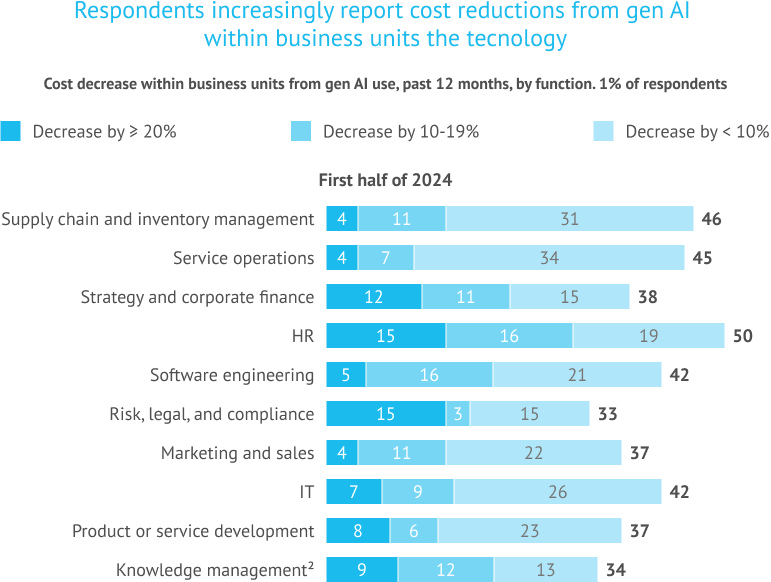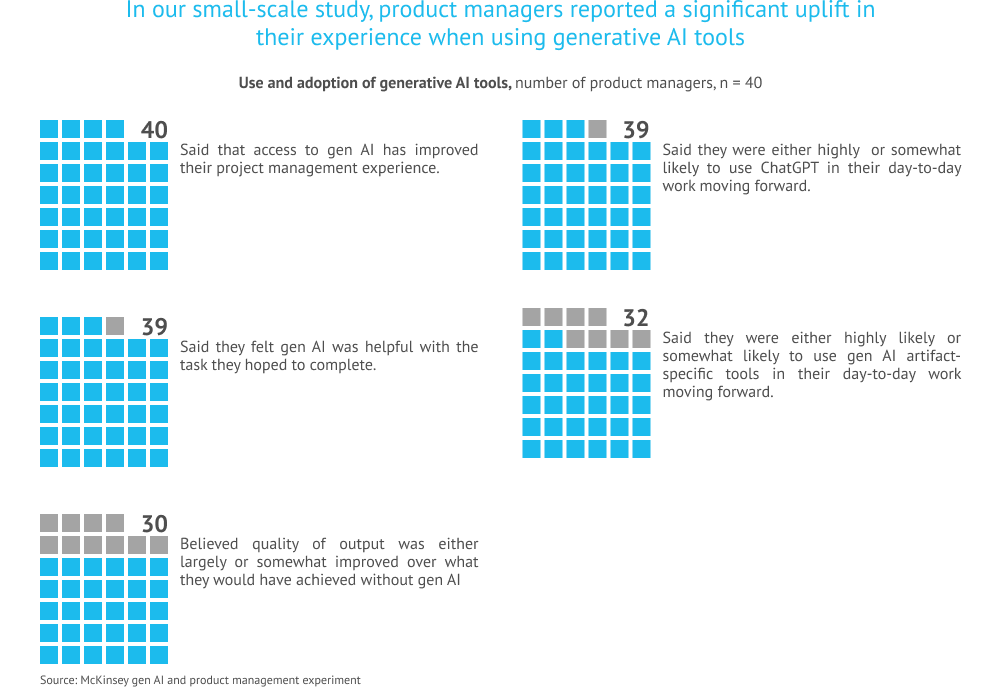Contents
- 1 What Is AI Business Process Automation?
- 2 Key Components of Business Process Automation Using AI
- 3 Benefits of AI for Business Automation
- 4 Real-World Use Cases of AI in Business Automation
- 5 The Challenges of Using AI for Business Process Automation
- 6 Best Practices for Implementing AI-Powered Business Automation
- 7 Future Trends in AI-Powered Business Automation
- 8 Conclusion
Rule-based automation scripts, while useful for repetitive tasks, can’t deal with the increasing complexity and variability of modern workflows. AI business process automation, also known as intelligent automation, leverages advanced technologies that can handle more complex tasks that require decision-making and reasoning.
AI automation is common across industries. McKinsey’s 2025 report shows that 92% of surveyed companies planned to increase investment in various AI technologies by 2028. So, what’s the role of AI in business process automation? And why should you implement it?
Our article describes real-world cases and the benefits of AI-powered business process automation. Finally, we also describe the strategies your team can apply to deal with common integration challenges.
What Is AI Business Process Automation?
To better understand AI-powered business process automation, we should start with regular automation.
Traditional business process automation means the strategy of applying technologies to streamline business operations. It usually relies on robotic process automation (RPA) tools that automate scripts and routine, repeatable tasks with fixed sequences.
Business process automation with AI combines RPA with other advanced technologies to deal with complex organizational tasks that require decision-making and cognitive skills. It’s not just about executing tasks, but also interpreting them and making predictions based on analysis with minimal human oversight.
AI-powered systems can evaluate and learn from past interactions and predictions. This allows them to refine their logic and make more accurate predictions and decisions.
Now, let’s look at the technologies that differentiate AI business automation from traditional tools.
Key Components of Business Process Automation Using AI
AI-powered automation is an ecosystem of interdependent components that enable businesses to automate, optimize, and refine operations. The key technologies include:
- Robotic process automation is a software technology capable of executing fixed instructions and rule-based scripts. These can include button-clicking, copy-pasting or formatting data, generating reports, and scraping websites. They get more intelligent when paired with other AI technologies.
- Machine learning (ML) models are algorithms that allow business process automation tools to detect patterns, classify information, and make predictions based on historical and real-time data. More importantly, these models become more accurate as they process and train on data.
- Natural language processing (NLP) enables software to read, understand, and respond to human language (typed, handwritten, or spoken). It’s essential to automate documentation management and communications.
- Computer vision gives AI systems the ability to interpret visual information (from product images to camera footage). When integrated with ML and ANN (Artificial Neural Network) models, AI can spot anomalies, extract structured data from an unstructured format, and flag inconsistencies.
- Artificial neural networks (ANNs) are computational models of interconnected nodes organized in layers (inspired by the human brain) that can recognize complex patterns in business operations. This component powers the ability to understand scanned documents with inconsistent formatting and recommend actions based on user behavior.
- Generative AI and large language models (LLMs) enable systems to create new outputs (text, images, video, code, or entire applications). GenAI technologies are now a usual component of most automation tools, including advanced chatbots and analytical software.
- Workflow orchestration engines coordinate how tasks execute across systems, applications, environments, or autonomous AI agents. This helps companies manage dependencies, timing, and execution logic within business automation systems.
These components work together to solve operational bottlenecks and add value to your organization.
Benefits of AI for Business Automation
When integrated strategically throughout the organization, AI business process automation reshapes how your employees approach work. This can translate into tangible benefits.
Productivity Boost
AI business process automation accelerates high-volume tasks and minimizes repetitive human workloads. In fact, McKinsey’s 2023 report predicts that the productivity impact of generative AI alone can add up to $4.4 trillion of value to the global economy.
According to McKinsey’s 2025 Superagency in the workplace report, 47% of employees use or plan to use generative AI to improve or automate their tasks. Due to improvements in AI, it could safely automate up to three hours of business processes per day. Such automation will free time from routine work, letting employees focus on creative work and innovation.
Cost Savings
Offloading mundane tasks to intelligent automation systems, especially with generative AI, can reduce operational costs. The impact differs based on the industry and business function.
For example, generative AI helped 50% of respondents in McKinsey’s 2025 report reduce the cost of HR activities. Over 45% slashed costs in service operations, and 46% in supply chain and inventory management.
Risk Reduction
AI systems maintain precision across millions of transactions while enforcing consistent logic. Algorithms simply don’t experience the lapses in concentration and fatigue that lead to missteps in redundant activities like data input or payment processing.
In an audit, AI can compare transaction logs with contracts and invoices to detect mismatches or policy violations. NLP models can also automatically generate accurate reports based on business intelligence data.
Improved Time-to-Market
McKinsey’s 2024 article on generative AI shows that companies using generative AI accelerated their products’ time-to-market by at least 5% due to improvements in employee efficiency and experience. What’s more interesting is that 75% of the managers believe that AI tools improved the quality of their deliverables.
Employees who use task-specific business process automation tools take less time to complete activities. For example, AI can synthesize existing research, help develop landing pages, and automatically create product backlogs.
Enhanced Customer Satisfaction
AI-driven automation improves customer service response times, helps personalize web and app interfaces, and delivers targeted ads. For example, AI chatbots can instantly respond to queries 24/7, billing bots can send alerts with instructions, and LLM-powered assistance can aid in complex tasks. All of this translates into improving the customer’s experience and impression of your business.
Automated Compliance
AI-powered business process automation tools can automatically log actions, protect sensitive information, and detect deviations in real time. This can help companies adhere to strict regulatory requirements and data privacy laws, such as GDPR, CCPA, and HIPAA.
Many AI tools can log access and actions to provide full traceability of business operations. Similarly, advanced AI agents can process documents without storing data at all: instead, they transmit the necessary information via encrypted channels. In addition, privacy-enhancing AI technologies, such as anonymization tools, can replace personally identifiable information (PII) within tables and documents.
Improved Employee Experience
AI tools, whether they completely automate repetitive work or assist in complex tasks, can elevate work morale. In McKinsey’s survey, advanced generative AI tools improved 100% of the software project managers’ product experiences. This contributed to productivity improvements, reduced burnout, and ultimately helped organizations retain professionals.
These advantages sound good on paper. But real examples are the best way to demonstrate how AI enhances business operations.
Real-World Use Cases of AI in Business Automation
The following AI business process automation examples show how companies can cut costs, boost efficiency, and improve user experience.
➤ Financial Reporting
In financial departments, AI business process automation can process invoices, transactions, expense claims, and contracts. It can extract and cross-check data across documents to identify mismatches or missing fields and compliance clauses. Similarly, ML models can flag anomalies and potential instances of fraud.
A US-based audit company, KPMG, deployed AI agents to automate substantive procedures such as expense vouching and liability testing. Moreover, KPMG’s 2023 survey found that nearly 65% of audit firms used AI automation in financial reporting.
➤ Supply Chain and Logistics
AI-enabled business process automation can manage warehouse operations, inventory levels, and logistical routes. Retail and e-commerce businesses implement intelligent models to predict demand based on past sales, current orders, and external events.
Amazon’s AI-driven supply chain uses ML and predictive analytics for inventory management, logistics route planning, and demand forecasting. Meanwhile, DHL deploys AI automation across operations, particularly in warehouse management and last-mile delivery.
➤ Manufacturing Operations
AI integrated with real-time sensor data helps detect quality issues on assembly lines and anticipate equipment faults. For example, Siemens has integrated predictive maintenance tools that detect current and future defects, helping to repair assets before they break and so avoid the associated expenses.
➤ Marketing and Sales
AI tools help segment customers based on demographic and behavioral data, monitor buying or churn signals, tailor messages, and trigger interactions.
For instance, Coca-Cola uses AI, automation, and business process optimization to analyze over 200 million consumer profiles, hyper-personalize recommendations, activate outreach at the right time, as well as manage tasks for marketing teams. Meanwhile, their designers generate and customize visual assets with generative AI platforms.
➤ Customer Service
Businesses across industries use AI-powered conversational platforms that can classify and tag incoming tickets and handle routine support queries. Salesforce is deploying AI agents that handle customer service interactions with 93% accuracy, reportedly performing up to 50% of support work.
As you can see, companies are trying to automate everything from finance operations to marketing and customer support. However, you may encounter several issues when adopting this technology.
The Challenges of Using AI for Business Process Automation
Knowing and addressing the technical limitations of AI and potential issues can mean the difference between a successful and a failed investment. Let’s look at the most common problem.
Availability of High-Quality Data
AI systems require consistent, relevant, and accurate data to operate reliably. Duplicated records, missing values, outdated information, and misaligned formats lead to flawed predictions, biases, and broken logic. It gets worse if the data is scattered across disconnected systems or in incompatible formats.
Strong data governance and processing can help avoid these problems:
- Deploy a centralized governance framework with defined data owners, access rights, approval protocols, and a data schedule.
- Remove duplicates, fill in missing information, and validate inputs before deploying data to AI models.
- Standardize data formats and create a unified data dictionary to ensure all names and identifiers follow consistent structures.
Fairness and Explainability
AI systems can reproduce or amplify societal, institutional, and operational biases in the training data. For instance, an anti-fraud AI automation tool exposed to skewed historical labeling may disproportionately flag specific demographic groups. That’s not something you want.
Lack of transparency is another major risk factor. Many high-performing models function as black boxes that don’t explain how they arrive at decisions. This can make AI incompatible with critical decision-making or in any highly regulated environment, especially in the legal sector and healthcare.
There are a few ways to deal with these challenges:
- Source training datasets across gender, age, race, geography, and other relevant dimensions.
- Use synthetic data generation to upscale or diversify your training data.
- Incorporate fairness indicators and schedule audits to evaluate AI automation models for fairness.
- Restrict the use of black-box systems in contexts where AI decisions affect legal, financial, or personal outcomes.
Legacy System Integration Problems
One of the most persistent problems is integrating legacy systems that run on outdated programming languages, lack APIs, and have proprietary data formats. This leads to some core processes being inaccessible to advanced models, which limits the transformative impact of an AI initiative.
To improve integration, companies can:
- Conduct a full audit of workflows, input/output dependencies, and failure points.
- Use APIs, middleware, data lakes, and ETL (Extract, Transform, Load) tools to break data silos from enterprise management platforms, third-party cloud services, and legacy software.
- Use RPA bots to interact with legacy interfaces, simulating keyboard and mouse inputs (for steps like data entry, batch uploads, etc.).
- Create logic layers that interface with legacy systems but expose standardized interfaces to AI automation tools.
Resistance to Change
Introducing AI-powered automation can spark internal resistance driven by fear of losing a job, unfamiliarity with new tools, or confusion about their purpose. In sectors like manufacturing, logistics, or customer support, to some employees, automated tools can appear to be a direct threat.
Leadership must address different aspects of AI adoption to ease the shift:
- Clearly communicate the objectives and impact of the AI automation initiatives, focusing on their benefits for productivity and employee experience.
- Acknowledge the potential role changes (for example, more employees may need to transition into positions that require critical thinking and software proficiency).
- Invest in training programs and reskilling initiatives, and involve employees early in pilot rollouts.
Security and Privacy Issues
While AI automation technologies can improve cybersecurity and threat detection, they still introduce vulnerabilities. AI tools access sensitive data, making them a high-value target for hackers. In addition to data breaches, attackers can infer or reconstruct sensitive information from a model’s outputs.
Besides, malicious actors can try to reverse-engineer outputs to leak internal logic or poison training data to introduce biases. Worst of all, compromised AI can distort entire workflows and decision chains.
A few solutions can greatly reduce these risks:
- Use enterprise-grade encryption protocols and tokenization for all data in transit and at rest.
- Enforce role-based access controls (RBAC), multi-factor authentication (MFA), and least-privilege policies for all automation components.
- Continuously audit systems for security standards and regulatory alignment (especially data minimization, sharing, and deletion policies).
- Deploy AI-powered anomaly detection technologies that can flag unusual behavior and isolate compromised components.
- Conduct regular penetration testing and red team exercises that simulate real-world attacks on the automation infrastructure.
Every challenge listed here is solvable, but only if you’re willing to follow proven strategies during the integration.
Best Practices for Implementing AI-Powered Business Automation
Many automation initiatives waste time and money due to poor planning or a lack of experience. To effectively deploy AI in business process automation and other areas of the organization, you should follow these practices:
Another essential part of your strategy is knowing where the technology is headed.
Future Trends in AI-Powered Business Automation
AI technologies are advancing quickly, and what’s optional today may become standard within the next two years. Below are the most noticeable trends shaping the future of business automation.
- About 70% of CEOs say AI-powered tools will reshape how their companies create and deliver value by 2027 (via PwC’s 2024 publication). Executives from Adobe, Amazon, and Pfizer confirm that the shift is underway, mentioning that they already use AI to personalize content, protect PII, accelerate development, and more.
- Organizations will aim to unify RPA, ML, NLP, data analytics, and low-code development to achieve hyperautomation. The market for hyperautomated solutions is set to grow from $12.8 billion in 2024 to over $41.2 billion in 2033 (as shown in the report from DataHorizzon Research).
- Edge computing will be used more frequently to move AI processing to local devices in an effort to minimize latency and enable offline functionality. The IDC’s 2024 report predicts that global spending on edge computing will reach $378 billion by 2028, up from $228 billion in 2024.
- Companies will integrate autonomous AI agents with business automation tools. According to MarketsandMarket’s 2025 report, this market will increase from $5.25 billion in 2024 to $52.62 billion by 2030.
Conclusion
AI business automation is already embedded into core operations across sectors. In addition to speeding up tasks and cutting costs, it can help you reduce risks, improve customer and employee satisfaction, and comply with regulations. That is, if you know how to deal with the limitations and integration challenges.
Not sure if you can deal with these challenges? DevCom can build AI tools that can automate your workflows. Our expertise covers custom AI process automation, advanced agentic workflows, and fully autonomous AI agents. Let’s discuss what kind of AI automation can benefit your company.












